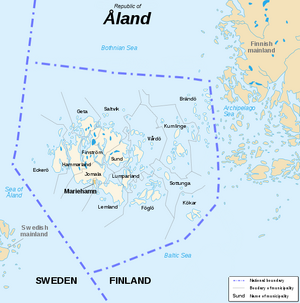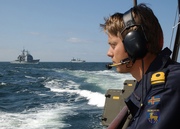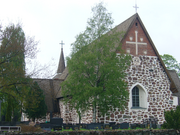|
| |||||
| Anthem | "Ålänningens sång" | ||||
| Capital (and largest city) |
Mariehamn | ||||
| Language | Swedish | ||||
| Religion | Ålandic Evangelical Lutheran Church | ||||
| Demonym | Ålandic, Åländsk (adj.), Ålander (n.) | ||||
| Legislature | Lagting | ||||
| President | Martti Ahtisaari | ||||
| Vice President | Olof Salmén | ||||
| Premier | Viveka Eriksson (Liberalerna) | ||||
| Area | 13,517 km² | ||||
| Population | 17,000 | ||||
| Established | 1921 | ||||
| Currency | Nordic Crown (NUK) | ||||
| Organizations | Nordic Union | ||||
Åland ([ˈoːland]; Finnish Ahvenanmaa) is a tiny island republic in the Baltic Sea between Sweden and Finland. As a member of the Nordic Union, Åland is the smallest of the Nordic nations, and the only one without a distinct language. It is also one of the youngest, its separate identity only dating back to the 1920s.
The islands are situated at the entrance to the Gulf of Bothnia. Åland was part of Finland before World War III and still maintains some political links with it. It is one of the smallest nations in the world, only about 0.49% of Finland's de jure land area.
Geography
The islands consist of the main island Fasta Åland (literally "Firm Åland"), where 90% of the population resides, and an archipelago to the east that consists of over 6,500 skerries and islands. Fasta Åland is separated from the coast of Sweden by 38 kilometres (24 mi) of open water to the west. In the east, the Åland archipelago is virtually contiguous with the Finnish Archipelago Sea. Åland's only land border is located on the uninhabited skerry of Märket, which it shares with Sweden.
History

Åland and its municipalities
Pre-Doomsday
Åland was part of the ancient Kingdom of Sweden, though administratively it was linked with Turku, Finland, in the seventeenth century. In 1809, Russia defeated Sweden in the Napoleonic Wars and seized all of Finland. Åland was included in this cession and was considered strategically important: it was said that "Russia would not take a trunk without the keys."
Åland was demilitarized in 1856 as part of the settlement ending the Crimean War. Nevertheless, the islands were used as a submarine base during World War I. As both Russia and Finland fell into civil war, Ålanders petitioned for annexation to Sweden. The new Finnish government offered the islands autonomous status within the new Republic of Finland, which the Ålanders rejected. The question was deferred to the League of Nations in 1921, which sided with Finland but forced them to guarantee Åland wide autonomy: it was to be fully self-governing, neutral, demilitarized, and would have Swedish as its sole official language.
Over the course of the twentieth century Åland began to develop an identity of its own, shaped by almost two hundred years as part of Finland. In 1970 the Nordic Council voted to allow Åland to send its own representatives as part of the Finnish delegation, a step on its way to being recognized as a separate "Nordic nation."
Doomsday and Aftermath
The Aland Islands, as a neutral region, were spared from the nuclear onslaught. However, Finland soon collapsed into violence as thousands of Soviet citizens desperately fled for the Finnish border, and riots and hysteria engulfed Helsinki and other cities. Åland was occupied by a radical anticommunist faction that had emerged in the area around Turku. The group saw the islands' advantages as an offshore base. Claiming to be the legitimate government of Finland, the group installed its own governor but did not abolish local self-government. In 1987 the faction accepted the authority of Finland's new transitional government, but a splinter group of diehards remained in control of Åland and parts of the mainland to the north of Turku.
Communication between Sweden and Finland was poor, but the former had to deal with its own tide of refugees fleeing Finland's riots and the border wars. Sweden had its own collapsing economy to deal with, but because of security needs its navy explored the Finnish coasts. Somewhat opportunistically, Sweden sent an expedition that landed on Åland late in 1987 to keep the peace. The Swedes installed a friendly governor, and soon after announced that they would "provisionally" re-annex Åland "as an emergency measure."
However, the islands were difficult for the resource-strapped Swedish government to defend. By 1990 Åland was claimed by both Sweden and Finland but was really almost totally on its own. It had become a rather notorious base for pirates who preyed on the slowly reviving local trade on the Baltic. Despite these challenges, Åland's elected legislature continued to administer the islands and do what it could to maintain the peace.
The Nordic Union and the Åland Question
When the Nordic Union was formed in 1990, Åland was a major point of tension between the struggling governments of Sweden and Finland. The other Nordic countries supported Finland and would not acknowledge Sweden's annexation of the islands, but Sweden, being in much better shape than Finland, used the promise of aid to apply pressure. Complicating matters more were representatives from Åland's own elected government, who asked for complete independence on the basis of the islands' "neglect" by Finland, and used their earlier membership in the Nordic Council as a precedent.
A compromise was reached in mid-1990 in the lead-up to the NU's creation. Finland agreed to give Åland still more autonomy, making it a fully sovereign republic. As a nod to history the President of Finland would remain the official head of state (represented by a local Vice President along the lines of an old Commonwealth of Nations Governor-General), but Åland would conduct its own foreign policy and would operate outside the authority of the Finnish Parliament.
Seeking Stability

An officer in the Ålandic Coast Guard on a joint maneuver with the Swedish navy
Åland was seated as an NU member in the First Expansion on September 26, 1991. Despite this diplomatic recognition, the islands remained dangerous and wild. With its thousands of islands, Åland was (and is) an attractive base for pirates. Restoring the rule of law, and rebuilding the shattered welfare state, were the chief concerns of the government for most of the next two decades. A Nordic Battle Group fleet helped dislodge a major pirate base in 2002, so that today piracy in the islands is mostly a small-time law enforcement problem.
Economy
Åland's entrance into the Nordic Union common market proved a great blessing. Though much of the population continues to rely on subsistence fishing and small-scale farming, the islands have revived greatly from the "dark age" of the 80s and early 90s. Some small-scale industry (carpentry, metallurgy) reappeared, but mostly Ålanders returned to doing what they had always been best at: shipping on the Baltic. Ålandic ships are active throughout the sea, in northern Germany and in surviving coastal villages of Latvia, Lithuania, and Poland, as well as in the Nordic nations. Tourism, naturally, seems gone for good.
Government and Politics
The President of Finland is Åland's head of state; the arrangement is modeled on the personal union joining Denmark to its former Atlantic colonies. The President appoints Åland's local Vice President to lead the state in his absence. Real power is vested in the Lagting, a parliament that dates to 1922. The Lagting chooses a Premier to lead the government, as well as a Speaker. The Vice President or President have veto power over Lagting decisions. These can be overridden with a 3/5 vote, but the veto power allows Finland to keep some check on Ålandic policy.
Åland sends three members to the Nordic Law Thing (Nordiske Lagting). Out of tradition, they are seated with the Finnish delegation. The elections of these three officers are considered more important than for Åland's Lagting itself, since they give the islands an important voice in world affairs. Åland has three main political parties: Liberalerna (liberal), Åländsk Center (centrist), and the Socialdemokrater (socialist). All three predate the war. A few new parties have arisen but do not play a major role in either the Ålandic or the Nordic Lagting.
Åland is no longer neutral or demilitarized. The new Nordic Union arrangements supercede the old laws passed after League of Nations arbitration in the 20s. The Nordic Battle Group began building a base in the strategic archipelago in 2005, but construction has stalled. Åland has no actual military, but the Coast Guard, the body mainly responsible for defense, comes very close. A small police force maintains order on land. Through the Nordic Union, Åland participates in the Atlantic Defense Community.
Culture
Language
Åland's only official language is Swedish, making it the only Nordic nation without its own distinct language. The Swedish language is one of the most important parts of the Ålandic identity. It is even mentioned in the last stanza of the national anthem: "Loudly shall it sound, our Swedish language, spoken with an urging voice." Åland's dialect of Swedish is distinct but is quite close to the standard and is certainly mutually intelligible with it.
A few Finnish refugees arrived in the years of civil war. Most have returned home, but there are more Finnish speakers in Åland than there were in 1980. Most have had to learn Swedish to get by.
Religion

The Church (now Cathedral) of St. Olaf in Jomala
Around three-quarters of Åland's population are members of the Ålandic Evangelical Lutheran Church (Åländsk evangelisk-lutherska kyrkan). The AELK is officially Åland's national church, but religious freedom is guaranteed to everyone.The churches were a great source of strength and solidarity during the "hard years" and are as important as ever to Ålandic society.
Until 2006, Åland's churches were part of the Diocese of Borgå, the diocese of the Church of Finland that oversees the country's Swedish-speaking parishes. In 2006 the infrastructure was finally in place for the islands to set up their own national church. Jomala, site of the islands' oldest and most centrally located church, was made the seat of the new bishop.
National Symbols
The oldest symbol of Åland is its coat of arms, which were granted by King Gustav I of Sweden in 1560. The design is unusual in that the islands have no deer. Interestingly, in 1940 it was discovered that the arms were granted in error. They had originally been intended for the island of Öland, where the king maintained a game park. Åland was supposed to have received a shield with nine roses to symbolize its connection to Finland.
Åland's national anthem, Ålänningens sång, was written in 1922. It praises both the natural beauty and the Swedish language of the islands.
Åland's flag was adopted in 1954. The process of choosing a flag was a difficult one, and many proposals were rejected for being either too Swedish or too Finnish. The red cross added to the gold cross of Sweden proved a workable compromise as well as a striking design. Its colors are explained as a combination of the chief colors of the coats of arms of Åland (gold and blue) and Finland (gold and red).
| ||||||||||||||||||||||

